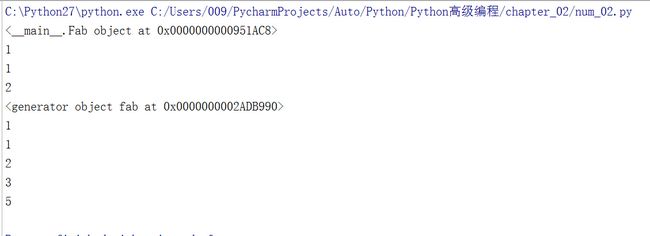Python 高级编程笔记之低于类别
前言:近日阅读《Python灰帽子-黑客与逆向工程师的Python编程之道》云里雾里,下一章节讲的到两个有名的调试器(PyDbg & Immunity debugger)。PyDbg环境搭建都搭建不好,各种问题,Immunity debugger环境搭建好了,也尝试玩了一下,按网上的教程编写了个小Demo,效果不佳,转战阅读《Python 高级编程》,现在笔记第二章节的内容。
目录:
- 列表推导
- 迭代器和生成器
- 装饰器
- with和contextlib
主要内容:
1.列表推导
# -*- coding:utf-8 -*-
import random
# 一般列表推导
print [i for i in range(10)]
# 使用enumerate进行列表推导
seq = ["1", "3", "5", "7"]
for i, el in enumerate(seq):
print "%d : %s" % (i, el)
# 列表推导随机生成手机号
print random.choice(['139', '136', '158', '151']) + "".join(random.choice("0123456789") for i in range(8))2.迭代器和生成器
# -*- coding:utf-8 -*-
# 迭代器有两个基本的方法
# next方法:返回迭代器的下一个元素
# __iter__方法:返回迭代器对象本身
class Fab(object):
def __init__(self, max):
self.max = max
self.n, self.a, self.b = 0, 0, 1
def __iter__(self):
return self
def next(self):
if self.n < self.max:
r = self.b
self.a, self.b = self.b, self.a + self.b
self.n += 1
return r
raise StopIteration
print Fab(3)
for i in Fab(3):
print i
# 带有 yield 的函数在 Python 中被称之为 generator(生成器)
def fab(max):
n, a, b = 0, 0, 1
while n < max:
yield b
a, b = b, a+b
n += 1
print fab(5)
for i in fab(5):
print i3.装饰器
# -*- coding:utf-8 -*-
# 装饰器是一个很著名的设计模式,经常被用于有切面需求的场景,
# 较为经典的有插入日志、性能测试、事务处理等。装饰器是解决这
# 类问题的绝佳设计,有了装饰器,我们就可以抽离出大量函数中与
# 函数功能本身无关的雷同代码并继续重用。概括的讲,装饰器的作
# 用就是为已经存在的对象添加额外的功能。
# 不带参数的装饰器
def deco(func):
def _deco():
print("before myfunc() called.")
func()
print("after myfunc() called.")
return _deco
@deco
def myfunc():
print("myfunc() called.")
return 'ok'
myfunc()
# 带参数的装饰器
def deco(func):
def _deco(a, b):
print("before myfunc() called.")
ret = func(a, b)
print("after myfunc() called. result: %s" % ret)
return ret
return _deco
@deco
def myfunc(a, b):
print("myfunc(%s,%s) called." % (a, b))
return a + b
myfunc(1, 2)
# -*- coding:utf-8 -*-
# contextlib是为了加强with语句,提供上下文机制的模块
from contextlib import contextmanager
from contextlib import nested
from contextlib import closing
@contextmanager
def make_context(name):
print 'enter', name
yield name
print 'exit', name
with nested(make_context('A'), make_context('B')) as (a, b) :
print a
print b
with make_context('A') as a, make_context('B') as b :
print a
print b
class Door(object):
def open(self):
print 'Door is opened'
def close(self):
print 'Door is closed'
with closing(Door()) as door :
door.open()
参考文献:
Python 迭代器 生成器
Python装饰器学习(九步入门)
总结:
书籍《Python灰帽子-黑客与逆向工程师的Python编程之道》是本好书,可惜初看时很难去理解,好好学习一下《Python 高级编程》,笔记中的装饰器,生成器,迭代器在代码中有看过,但没去深入的了解这些,今天算是补一补了
本人利用Bootstrap + EasyUI + Django开发网站:http://www.xuyangting.com/ 欢迎来访
阳台测试: 239547991(群号)
本人博客:http://xuyangting.sinaapp.com/


